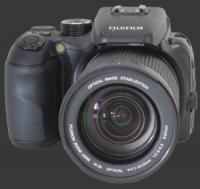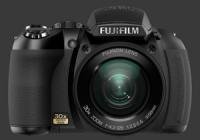Fujifilm Finepix HS10 Review
Fujifilm Finepix HS10 Performance - How well does it take pictures?
The Fuji Finepix HS10 produces good quality images with lower than average noise but a slight smudging of fine details at all ISO. Still, ISO 100 to 400 are perfectly usable for anything but large prints. ISO 800 gets just enough added softness to limit prints to 9"x12" or so. It is worth noting the flagship Fuji Finepix S200EXR and its older sibling, the Fujifilm Finepix S100FS
Fujifilm Finepix S100FS, have a noticeable lead in this regard. The new CMOS sensor also does not have the extended dynamic range capability and low-noise mode of the SuperCCD EXR used in the S200EXR. At ISO 1600 and 3200, only small prints are usable.
It is obvious that Fuji had to work hard to keep noise low on the HS10, in order to use the CMOS sensor's high-speed capabilities required for 1080p video and multishot modes. While the first hint is the smudging of details, the second is limited shutter-speeds and extra processing done when images are captured at 1/2s or below. When this happens, it takes an extra second between shots. As noted in the capability page, the slowest shutter-speed diminishes by a stop for each ISO stop over 100.
The ultra-wide 30X optical zoom lens is the the biggest achievement of the HS10. It performs incredibly well for such a never-before-seen range. Except for a softening towards the edges of the frame near the ultra-wide end of the range, about 24-27mm, sharpness is really quite good. Distortion is barely visible at the wide-end and is nowhere to be seen elsewhere. There is a tendency to flare much more than with normal lenses though. The HS10 seems unaffected by chromatic aberrations and produced over-exposed areas with clean edges during the review period. This is a significant improvement for Fujinon lenses, as this is usually their only problem. A bit of vignetting shows at the long end of the zoom.
The lens starts at a bright F/2.8 maximum aperture and its closes down slowly while zooming in, only reaching the smallest maximum of F/5.6 passed 500mm. There is a 58mm for using optical filters.

Fuji's exposure system is exemplary and rarely needs compensation to avoid blowing highlights. This is a bit more conservative than most consumer models and some pictures may be appear to dark to print directly. The unfortunate problem is that the LCD and EVF do not preview exposure consistently, so results can be surprising.
Colors are generally good with a slight undersaturation by default, something which is easy to correct. White-balance is also generally good, certainly on par with most good ultra-zooms. There is a slight yellow cast to images taken under incandescent light in automatic but the 6 presets are good and custom white-balance is close to perfect.

The speed of the Fuji Finepix HS10 is truly mixed. A few numbers like a startup time of 2 seconds are average. A few are better like the quick shutter-lag and power-off time of under 1s. Some are too slow, like the time for achieve focus lock, around 1s for most scenes and the shot-to-shot speed is glacial at over 4s. This is clearly not a camera designed for action, despite the speed of its burst modes. Otherwise, the camera does generally remain responsive. Except while recording an image, a button press is usually answered almost immediately.
Entering and exiting playback mode is quite fast. Since this is a shooting-priority camera, it instantly goes back into shooting mode when pressing the shutter halfway. Scrolling through images is fast. Panning and zooming is reasonable.
The Fuji Finepix HS10 uses AA batteries which are the most convenient type of batteries. Compared to other types of batteries, they are very cheap. They also come in different types and disposable ones are available in most places. Depending on the type of battery used, the HS10 can have good battery life but it is also very picky about batteries. Some AAs, even fully charged, give a little less than 100 shots, which is quite poor. The best performance obtained were from Maha PowerEx NiMh batteries for rechargeable batteries.
Fujifilm Finepix HS10 Conclusion
This ultra-zoom digital camera performs well while defining itself by a unique 30X optical zoom that goes from ultra-wide to super-telephoto using a mechanical zoom ring. This lens comes along with a camera body designed for direct access to its manual controls in a comfortable SLR-style body.
Optically, results are impressive with good sharpness away from the ultra-wide end, low distortion, barely any vignetting and extremely good control over chromatic aberrations. The rest of image quality is also good with low-noise, generally good color and reasonable white-balance. The compromise though is a smudging of fine details at all ISO which limits possible print sizes compared to class-leading performers.
Despite a speedy CMOS sensor , the HS10 ends up being slow on two important aspects: autofocus speed and shot-to-shot speeds. The displays are also problematic with both both poor coverage and incorrect exposure preview. All this adds up to a good but not stellar performance.
In the end, the Fuji Finepix HS10 is most suitable for taking pictures of just about any static scene, close or far, as long as light is not too low. Video recording comes with the same issues plus a lengthy 4s startup delay. The importance is to realize that the HS10 is defined by its optical zoom range. If ultra-wide and super-telephoto are needed, no competitors exist. This digital camera represents a light-weight package for such capability, making it a very convenient travel camera.
|
Overall Score: 
|
 |
Please Support Neocamera
All information on Neocamera is provided free of charge yet running this website is a huge endeavor. Purchases made via affiliate links found throughout the site help keep it running and up-to-date. There is no additional cost to you, so please consider buying via these links to our affilates:
If you found any information on this site valuable and did not purchase via our affiliate links, please considering donating via PayPal:
Any amount will be greatly appreaciated. Thank you for your support!
Fujifilm HS10 Highlights

Sensor-Size: 6 x 5mm

Actual size when viewed at 100 DPI
| 10 Megapixels Ultra Zoom | ISO 100-6400 |
| 30X Mechanically Linked Ultra-Wide Optical Zoom | Shutter 1/4000-30s |
| Built-in Stabilization | Full manual controls, including Manual Focus |
| 0.20" Built-in EVF 200K Pixels | Custom white-balance with 2 axis fine-tuning |
| Automatic Eye-Start sensor | Spot-Metering |
| 10 FPS Drive, 7 Images | Hot-Shoe |
| 1920x1080 @ 30 FPS Video Recording | Standard AA Battery |
| 3" LCD 230K Pixels | Secure Digital High Capacity, Internal Memory |
BSI CMOS
About a dozen digital cameras now use a 10 megapixels BSI (Back-side-illuminated) CMOS sensor. The BSI part promises to produce lower image noise than traditional designs by allowing more light to be captured instead of being blocked by circuitry. The CMOS part allows faster output and therefore fast continuous drive and features which require multiple images taken close together.
Fuji probably faced a huge dilemma here because they already had superior low-light technology in using CCD technology and - as the results of this review show - they still have. Unfortunately, they did not use this technology in the HS10, most likely in favor of high-speed benefits brought by the new CMOS sensor.
The most significant high-speed feature is full 1080p HD video recording, followed by the 10 FPS continuous drive. Aside from the 4s it takes to start recording video, the HD feature delivers. The continuous drive is also put to good use by providing pre and post shooting capture and four speeds of operation. Due to limited processing power in the camera, bursts are limited to 7 frames though.
The remaining high-speed features should be seen as mostly experimental, as they have potential but of limited success currently, most likely because of a slow image processing pipeline. All advanced scene modes and the panorama mode require many images to be processed in order to produce their results.
The most successful advanced mode is Pro Low-Light. It combines 4 exposures to create a full-resolution image while simulating using a high-ISO. The difference can be seen in the samples page, just look at the ISO 800 pair.
Both Motion-Remover and Multi-Motion Capture produce a half-resolution image from 5 images taken using a set interval between each frame. They can produce images that work but they tend to miss more often and there is a lot of trail-and-error involved.
Updates
2025.01.18

Fujifilm GFX 2025 Lens Roundup
Lens Review roundup of Fujifilm GFX Medium-Format lenses. Quality, performance and handling of the GF20-35mm F/4R WR, GF30mm F/3.5 Tilt-Shift and the GF55mm F/1.7.
2024.11.18

Best 2024 Photography Gifts for Every Budget
Great gifts for photographers and photo enthusiasts selected for every budget among the best products of 2024.
2024.08.07

Eye Protection Tips for Professional Photographers
The four main considerations for professional photographers regarding eyewear.
2024.07.14

Fujifilm X100VI Review
Flagship fixed-lens compact digital camera with a 40 MP sensor and Image-Stabilization, a first for the series. Retro design featuring dual control-dials, plus direct ISO, Shutter-Speed and EC dials. Its hybrid viewfinder can switch between EVF and OVF mode.
2024.05.09

Fujifilm GFX100 II Review
Flagship 102 Megapixels Medium-Format Mirrorless Digital Camera with 8-Stop 5-Axis IBIS, 8 FPS Drive, 8K Video and 400 MP Super-Resolution capture in a weatherproof and freezeproof body with dual control-dials and dual memory-card slots.
2024.04.03

Fujifilm X-T5 Review
Newest Fujifilm flagship boasting a 40 MP APS-C sensor, 5-axis IBIS with 7-stop efficiency, 15 FPS continuous drive, 6.2K Video capture, dual control-dials and dual SDXC UHS-II slots in a sturdy weatherproof and freezeproof body.
2023.11.20

Best Digital Cameras of 2023
Find out which are the Best Digital Cameras of 2023. All the new Mirrorless Digital Cameras from entry-level to high-end professional.
2023.07.10

Fujifilm X-H2 Review
40 Megapixels APS-C Hybrid Mirrorless Digital Camera with 7-stop IBIS. Fastest shutter ever and 8K video capture. Large builtin EVF with 0.8X magnification and 5.8 MP, plus an Eye-Start Sensor. Packed with features and large number of controls in a weatherproof and freezeproof body.
2023.05.07

Sony FE 20-70mm F/4G Review
Review of the unique Sony FE 20-70mm F/4G lens. The optical zoom of this lens spans ultra-wide-angle and medium focal-length coverage, making it one of the most versatile Full-Frame lenses on the market.
2023.01.15

Huion Inspiroy Dial 2 Review
Review of the Huion Inspiroy Dial 2 tablet, a medium sized drawing surface with dual dials and customizable buttons. Connects via USB-C or Bluetooth 5.0 with Windows, Linux and Android support.
2022.12.08

How to Pack for a Photo Trip
Find out how to pack for a travel photography trip, carry your gear safely while meeting airline regulations.
2022.11.13

Best Digital Cameras of 2022
The best digital cameras of 2022. A short list of the most outstanding models in their respective categories. Choose one for yourself or as a gift.











